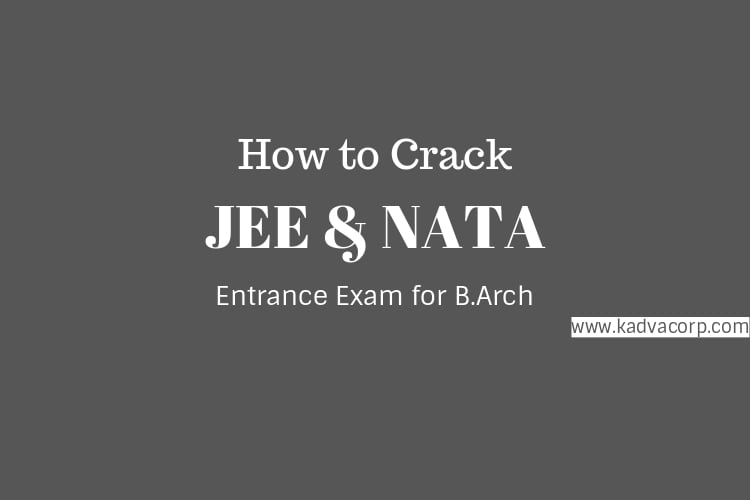Before we are beginning to get details about JEE and NATA entrance exam for B. Architecture with their preparation resources like sample papers, how to apply and so on. Few important things need to clear in your mind regarding NATA and JEE exams. Here are the basic quality students must have is an interest in the subject of architecture. They must have an imaginative mind and the passion to draw. Sometimes the students might also be asked questions on architectural awareness. There is also a possibility that they might be asked to identify national and international buildings of prominence. As to answer all these types of questions correctly, students need to have a very good idea on all subjects pertaining to architecture. Students can read newspapers and journals that have good articles on buildings and their structures. They can also refer the internet for more details. Apart from this, they can prepare for the written examination by reading reference books and practice on old question papers. This will give students an idea of how the JEE and NATA architecture entrance exam is and will give them more confidence to attend the NATA exam without much fear.
Tips to Prepare for JEE and NATA Entrance Exam.
So, we are getting through knowledge about JEE entrance exam and NATA entrance exam for architecture admission. This will also help in preparation of engineering courses admission after 12th.

JEE and NATA Entrance Exam Eligibility:
- Candidates should have passed class 12th with Mathematics as a subject or done diploma from a recognized institute/university/board with at least 50% aggregate marks in 12th/diploma.
- Candidates with International Baccalaureate Diploma having 50% aggregate marks and Math as a subject can also apply.
- The candidates should be resident of India and should have attained a minimum age of seventeen years as on 01st of July of the ensuing year of the entrance test.
- Furthermore, the candidates should be mentally as well as physically fit during the admission process.
Know more about Which Personal Characteristics of Architect Become Them Best? Find Out.
NATA Entrance Exam.
NATA EXAM: National Aptitude Test in Architecture or NATA measures the aptitude of the applicant for architecture. The NATA exam test measures drawing and observation skills, sense of proportion, aesthetic sensitivity and critical thinking ability required for architecture.
What is NATA entrance exam?
The National Aptitude Test in Architecture (NATA) is a national level examination for admission to undergraduate courses in Architecture. The test measures aesthetic sensitivity and critical thinking of the candidates.
Why is NATA entrance exam important to take admission in architecture?
NATA entrance exam score is required for taking admissions to 1st-year B.Arch. at all institutes/schools /colleges of Architecture in India. (Including Govt., Govt-aided, Private Unaided, University Depts. Deemed Universities, etc.). Offering courses, and leading to Bachelor’s degree in Architecture. The NATA entrance test is conducted throughout the year at designated test centers located in various parts of the country. Candidates can attempt NATA Exam for a maximum of 5 (Five) times during the period when their latest scorecard is valid.
Here is one more perfect education in Bsc in applied business analytics source for your future preference.
Check this out,
- Top Indian Architecture And Design Bloggers List.
- Professional Ethics and Code Of Conduct for Practicing an Architect in India.
- Know more about Urban Design Thesis Topics Ideas.
NATA Exam Date:
Who conducts the NATA exam?
The National Institute of Advanced Studies in Architecture (NIASA), Pune and an Academic Unit of the Council of Architecture (COA) are conducting NATA entrance exam.
Generally, the NATA exam held in the month of April to May. You can give NATA exam papers during this period as per the pre-decided schedule of the designated Test Centers. Appointments are scheduled on a first-come, first, serve basis.
Important Dates of NATA Entrance Exam for B.Arch:
- Registration Start: In the month of January.
- NATA Exam Start: In the month of April.
- Last Date of Exam: Month of August.
- Last Date of Registration: Appx. The month of August.
For final dates and schedules, you have to visit NATA official website.
NATA Entrance Exam Registration Online:
NATA Exam Application Form:
Online Registration for NATA Forms will begin from March. The detailed brochure, the procedure for application shall be released on this website of NATA.
NATA entrance exam registration form can fill and submitted ONLINE from this website by payment of NATA fees of Rs. 1250.00 (+Processing Charges) using Net banking / Credit Cards / ICICI Isure Bank Challan.
- Download the Prefilled Registration form and procure the necessary registration documents.
- Select a Test Center/Region (from the website http://www.nata.in) at a location convenient to the candidate.
- Approach the Test center for Appointment for NATA Exam.
The structure of the National Aptitude Test in Architecture (NATA):
The time period of this test is 3 hours. The NATA exam has 2 parts.
- Paper Based Drawing Test.
- Computer Based Online Aesthetic Sensitivity Test.
The Paper Based Drawing Test is of two hours which consists of two questions with each question containing two sub questions. NATA includes an optional 10-minute break after the Drawing section. This break time cannot be exceeded. Negative marking is absent in this exam. The paper carries a total of 200 marks. Those who secure more than 100 marks will get admittance to the institution of their choice.
Syllabus of the National Aptitude Test in Architecture (NATA):
As mentioned above, the NATA entrance exam has two parts.
NATA Drawing Test:
The first part: Paper Based Drawing Test, has a duration of two hours. The paper will carry 2 questions. These questions will have two sub questions. The drawing aptitude is judged on the following aspects-
- Ability to sketch a given object proportionately and rendering the same in visually appealing manner.
- Visualizing and drawing the effects of light on the object and shadows cast on surroundings.
- The sense of perspective drawing.
- Combining and composing given three dimensional elements to form a building or structural form.
- Creating interesting two-dimensional compositions using given shapes and forms.
- Creating visual harmony using colors in given composition.
- Understanding of scale and proportions.
- Drawing from memory through pencil sketch on themes from day to day experiences.
NATA Aesthetic Sensitivity Test:
The second part: Computer Based Aesthetic Sensitivity Exam has a time period of two hours. The paper will have 40 questions with 3-4 options each. The aesthetic sensitivity test measures perception, imagination and observation, creativity and communication along with architectural awareness and comprises of-
- Visualizing three-dimensional objects from two-dimensional
- Visualizing different sides of three-dimensional
- Identifying commonly used materials and objects based on their textural qualities.
- Analytical reasoning.
- Mental Ability.
- Imaginative comprehension and expression.
- Architectural awareness.
Reference Books for the National Aptitude Test in Architecture (NATA):
Architecture Entrance Book by P.K. Mishra
Arihant Book’s A Complete Self Study Guide for B. Arch Entrance Examinations.
B Arch Exam Guide by PK Mishra
NATA/AIEE B.Arch. Question Bank-2011
Verbal & Non-Verbal Reasoning Book by R.S. Agarwal
Study Plan for the National Aptitude Test in Architecture (NATA)
Download Sample of NATA Entrance Exam Previous Year Question Papers with answer keys: Coming soon,…
NATA Entrance Exam Score Cards/Results:
The NATA test score cards will be available on NATA website in e-format. Usually, the score cards will be posted on the website on the fourth working day after the test. The candidate, after the fourth day, may check his score directly from a website giving his/her candidate ID.
However, print out taken by the candidate of such score card will be only for reference and information. Candidate, however, may use the print out of this score card while applying for the admission if the admission authority calls for the same.
The original score card will be retrieved and verified by the admission authority directly from NATA server. Only the score card stored on NATA server is valid and no print/hard copy will be considered valid. The NATA score shall be valid for a period of two years from the year in which the applicant appeared for the NATA Test.
NATA Address:
Address of Council of Architecture:
- India habitat Centre, Core 6-A, 1st Floor, Lodhi Road, New Delhi- 110003
- Phone: 011-24648415, 24654172, 020-6573-1088
- Email: admin.nata@gmail.com
- Website: www.nata.in
JEE Entrance Exam.
Below, we are collectively as much as possible detail information regarding JEE exam. Hope, that will help you to crack the door of your interest in future.
What is JEE entrance exam?
Joint Entrance Examination (JEE) is a nationwide entrance examination that is organized by CBSE (Central Board of Secondary Education). This competitive test is conducted for admittance to various undergraduate architecture and engineering courses in institutions across India.
Latest new JEE entrance Exam Patterns:
JEE main entrance exam pattern is thoroughly objective. It consists of two papers.
- Paper 1 for engineering aspirants and,
- Paper 2 for architecture applicants.
Mode of examination for paper one will be online as well as offline. Whereas the mode of examination for papers two will be offline.
JEE (B.Arch) Entrance Exam Pattern:
JEE Entrance Exam Part – I:
Aptitude = 40 questions x 4 marks = 160 marks.
Math = 40 questions x 4 marks = 160 marks.
Awareness of persons, places, Buildings, Materials.
Objects, Texture related to Architecture and building environment.
Visualizing three-dimensional objects from two-dimensional drawings.
Visualizing different sides of three-dimensional objects.
Analytical Reasoning Mental Ability (Visual, Numerical and Verbal).
JEE Entrance Exam Part – II:
Drawing = 2 questions x 35 marks = 70 marks.
Three dimensional – perception: Understanding and appreciation of scale and proportion of objects, building forms, and elements, color texture, harmony, and contrast.
Design and drawing of geometrical or abstract shapes and patterns in pencil.
Transformation of forms both 2 D and 3 D union, subtraction, rotation, development of surfaces and volumes, Generation of Plan, elevations and 3 D views of objects.
Creating two dimensional and three-dimensional compositions using given shapes and forms.
Sketching of scenes and activities from memory of urbanscape. (Public space, market, festivals, street scenes, monuments, recreational spaces etc.), landscape (river fronts, jungles. gardens, trees, plants etc.) and rural life.
JEE Main Paper 2 for B.arch having questions regarding architecture where students must be familiar with acclaimed national and international buildings. Candidates drawing skills will be tested in drawing test. For the accounting to how well a candidate will be able to depict their surrounding observation through drawings.
In addition to this candidates must have a clear notion of relevant topics and exam pattern.
The timing of JEE entrance exam for B.Arch:
B.Arch (JEE) is a three hours duration paper consisting of Sketching/Drawing Test, Mathematics, and Aptitude.
Syllabus For JEE Entrance Exam for B.Arch:
Drawing Test:
Designing and drawing of geometrical patterns, 3D observations, colors and textures, building forms and elements, harmony and contrast, plan generation, development of surfaces and volumes, 2D and 3D transformation union, subtraction and rotation.
Aptitude Test:
3D objects visualization from 2D drawings, Texture related Architecture, objects, analytical reasoning and mental ability, Awareness of build-environment and 3D objects visualization.
Maths Test:
Three Dimensional Geometry, Induction, Relations and Functions, Integral Calculus, Vector Algebra, Quadratic Equations, Differentiability, Coordinate Geometry. Statistics and Probability, Matrices and Determinants, Simple Applications of Binomial Theorem, Mathematical Reasoning, Limit and Continuity, Complex Numbers, Sets, Sequences, and Series.
And in the last,…
Know more about Indian Architecture:
- Best Architecture Colleges In India : Become An Architect Of Tomorrow
- How to select the best architecture dissertation topics for final year thesis?
- Innovative architecture thesis topics list for b.arch final year dissertation ideas
- Theory of Design in Architecture for Create Design Concept
- What is Organic Architecture Concepts Characteristics and Definition?
Best Tips to Crack B. Architecture Entrance Exam:
The importance of School Studies:
The first and foremost step towards preparation of JEE exam is to pay attention in class 11 and class 12 as most of the concepts. That is taught in a class (recognized boards) are covered in JEE Main and JEE Advanced syllabus.
Study Plan:
Understand the concepts clearly before proceeding to next topic. Segregate your syllabus into weekly and monthly sectors. Make use of Engineering Drawing Note for 2D/3D questions preparation. To avoid tedious repetition, try to add variation in your daily study schedule (i.e. studying Drawing, Math’s and Aptitude related concepts).
Time Management:
Time Management is one of the key aspects for success. And time must be spared to each subject. Most of the IITians start preparing for exam one year before the examination.







Leave a Comment
You must be logged in to post a comment.